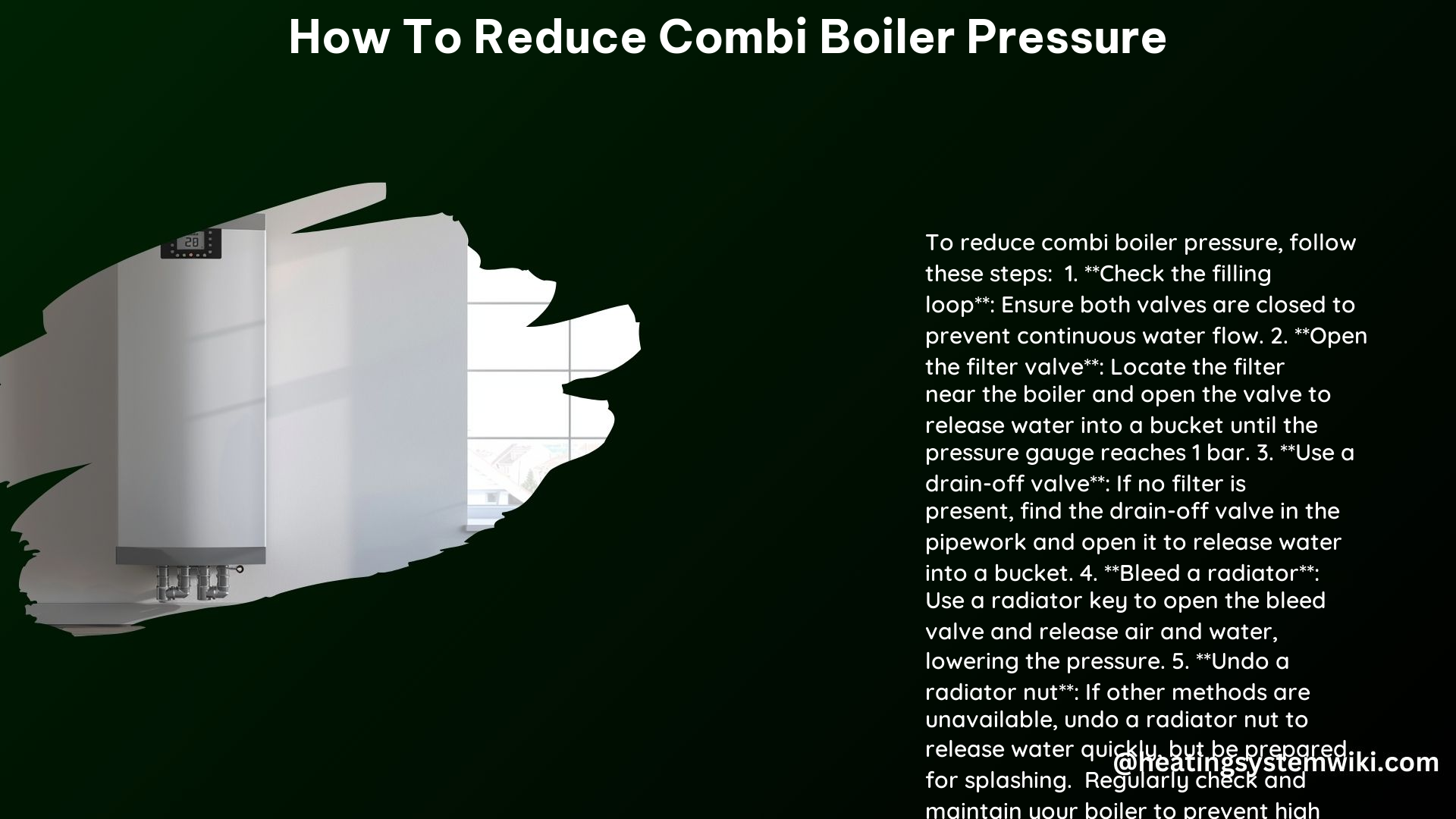Maintaining the optimal pressure in your combi boiler is crucial for its efficient and safe operation. High boiler pressure can lead to complete system failure, making it essential to address this issue promptly. This comprehensive guide will walk you through the step-by-step process of reducing combi boiler pressure, providing you with the technical specifications and precautions to ensure a successful and safe DIY experience.
Check the Control Panel
The first step in reducing combi boiler pressure is to check the control panel. Ensure that the boiler pressure is above the recommended range of 1 to 1.5 bar when the heating is turned off, and between 1.5 and 2 bar when the heating is turned on. If the pressure exceeds 2.5 bar, it indicates high pressure, which can potentially lead to complete boiler failure over time.
Inspect the Boiler Valve or Filling Loop

Next, verify that the boiler valve or filling loop is tightly sealed. An open valve can cause high boiler pressure, so it’s essential to ensure that these components are properly closed. Check the valve or filling loop and make any necessary adjustments to ensure a tight seal.
Bleed the Radiators
Bleeding the radiators is a crucial step in reducing combi boiler pressure. Use a radiator key to release air from the radiators, which will help reduce the pressure in the central heating system and, in turn, the boiler pressure. Remember to ensure the boiler is cold before bleeding the radiators to avoid the risk of burns from hot water.
Utilize the Filter Valve or Drain-Off Valve
If your system has a filter valve, open it to release pressure. This valve is typically located near the boiler and can be used to drain impurities from the system. Alternatively, use a drain-off valve (also known as a drain cock) located in the pipework. Open the valve to release pressure, then close it when the pressure gauge reaches 1 bar.
Undo a Radiator Nut (Advanced)
This method should only be attempted by confident DIYers. Undoing a radiator nut can quickly release pressure, but be prepared for splashing water. Ensure the boiler is cold before attempting this step to avoid the risk of burns.
Technical Specifications and Precautions
Ideal Pressure Range
The ideal boiler pressure is between 1 and 1.5 bar when the heating is turned off and between 1.5 and 2 bar when the heating is turned on. Maintaining this pressure range is crucial for the efficient and safe operation of your combi boiler.
Safety Precautions
Always ensure the boiler is cold before attempting to reduce pressure. Never attempt to carry out maintenance work on your boiler without the help of a professional, as this can jeopardize your safety and void your warranty.
Regular Servicing
Regularly servicing your boiler is essential to identify and address any issues that may contribute to high pressure. This will help ensure the long-term reliability and efficiency of your combi boiler.
Additional Tips
Check the Filling Loop
Ensure the filling loop valves are fully closed to prevent overfilling, which can cause high pressure.
Inspect the Expansion Vessel
If the expansion vessel is faulty or damaged, it can cause high pressure. In such cases, do not attempt to inspect or fix it yourself; instead, call a professional.
By following these steps and considering the technical specifications and precautions, you can effectively reduce the pressure in your combi boiler and ensure safe and efficient operation. Remember, if you are unsure or uncomfortable with any of the steps, it’s always best to consult a professional for assistance.
References:
- JustServicesGroup. (2022). How To Reduce Boiler Pressure – JustServicesGroup. Retrieved from https://justservicesgroup.com/blog/boilers/how-to-reduce-boiler-pressure/
- Heating Help. (2018). Boiler pressure more than 20 psi – Heating Help: The Wall. Retrieved from https://forum.heatinghelp.com/discussion/164637/boiler-pressure-more-than-20-psi
- John Owens Services. (2021). How to Increase or Reduce Boiler Pressure – John Owens Services. Retrieved from https://johnowensservices.com/2021/08/how-to-increase-or-reduce-boiler-pressure/
- Ideal Heating. (n.d.). Boiler Pressure Too High? Here’s How to Fix It | Ideal Heating. Retrieved from https://idealheating.com/tips-and-advice/boiler-pressure-too-high-heres-how-to-fix-it
- YouTube. (2019). How to reduce the water pressure – Central Heating – YouTube. Retrieved from https://www.youtube.com/watch?v=UR9wSU-I2O8
